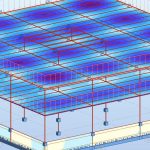Stress Distribution In Soil
Displacements in soil occur from stresses applied by loading forces. The distribution of stress in soil should be known for realistic estimates of displacements caused by applied loads on the supporting soil.
The following methods may be used to estimate the stress distribution of soil for an applied load Q at the center point of an area. Practical calculations of settlement are based on these estimates of stress distribution.
APPROXIMATE 2:1 DISTRIBUTION
An approximate stress distribution assumes that the total applied load on the surface of the soil is distributed over an area of the same shape as the loaded area on the surface, but with dimensions that increase by an amount equal to the depth below the surface, Fig-1.
At a depth z in feet below the ground surface the total load Q in tons applied at the ground surface by a structure is assumed to be uniformly distributed over an area (B + z) by (L + z). The increase in vertical pressure Dsz in units of tsf at depth z for an applied load Q is given by
Dsz = Q / [(B + z) * (L + z)]
Where,
B and L are the width and length of the foundation in feet, respectively.
Dsz is the increase in the vertical pressure caused by the construction.
Vertical stresses calculated by above equation agree reasonably well with the Boussinesq’s method.



